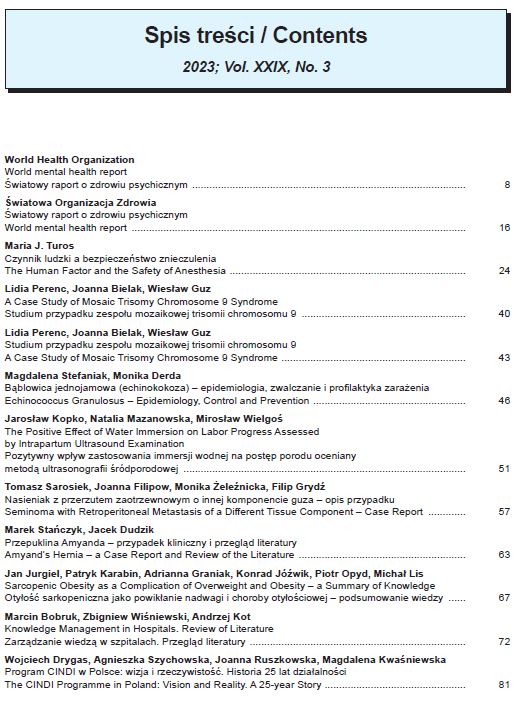Szanowni Państwo, drodzy Czytelnicy,
oddaję w Państwa ręce trzeci numer XXIX tomu kwartalnika „Review of Medical Practice”. W aktualnym wydaniu prezentujemy Państwu wiele interesujących publikacji. Na uwagę zasługuje opracowanie dr n. med. Marii J. Turos ze Studium Etyki Lekarskiej i Medycyny Paliatywnej Warszawskiego Uniwersytetu Medycznego pod tytułem Czynnik ludzki a bezpieczeństwo znieczulenia. Autorka stwierdza, że czynnik ludzki, choć na ogół uważany za subiektywny, stanowi istotny aspekt bezpieczeństwa działań, szczególnie w obszarach, w których dochodzi do interakcji z drugim człowiekiem. Dodatkowo nakładają się procedury wykorzystujące aparaturę kontrolno-pomiarową. Również komunikacja wewnątrzzespołowa jest zaliczana do istotnych czynników wchodzących w zakres prezentowanej tematyki. Świadomość, jak wielką rolę odgrywają te interakcje w zapewnieniu bezpieczeństwa pacjenta, jest istotnym czynnikiem unikania błędów. Poruszany przez autorkę problem jest istotny, ponieważ z intuicyjnego i empirycznego punktu widzenia zarządzanie i praca zespołowa są niezbędne dla bezpieczeństwa pacjenta oraz rezultatów postępowania anestezjologicznego i opieki okołooperacyjnej. Obecne badania potwierdzają koncepcję, że podczas standaryzowanej rutynowej pracy zwykle nie jest wymagane przywództwo, ale aktywne, a nawet dyrektywne przywództwo jest ważne nieoczekiwanych, nowych lub stresujących sytuacjach. Równie istotny w pracy zespołu jest sposób komunikacji oraz przepływ informacji pomiędzy jego członkami, którzy narażeni są na wiele czynników stresogennych, szczególnie w zdarzeniach krytycznych.
Kolejną interesującą publikacją jest artykuł Studium przypadku zespołu mozaikowej trisomii chromosomu 9 prof. Lidii Perenc z Instytutu Nauk o Zdrowiu Uniwersytetu Rzeszowskiego i współautorów. Zespół mozaiki trisomii 9 został opisany w 1973 roku przez amerykańskiego genetyka R. Haslama; w aktualnych danych uzyskanych z portalu orpha.net zaliczany jest do chorób rzadkich. W artykule omówiono przypadek kliniczny mozaikowej trisomii chromosomu 9 u niemowlęcia płci męskiej. Autorzy wskazują, że dla ustalenia prawidłowego rozpoznania należy uporządkować dane uzyskane na podstawie wywiadu, badania przedmiotowego i badań dodatkowych. W przypadku podejrzenia nieprawidłowego genotypu jako czynnika etiologicznego należy wykonać odpowiednie badania genetyczne. Warto również porównać obraz kliniczny i historię choroby pacjenta z danymi przedstawionymi w literaturze.
Z poważaniem
Redaktor Naczelna
dr hab. n. med. Anna Wilmowska-Pietruszyńska, prof. UŁa
